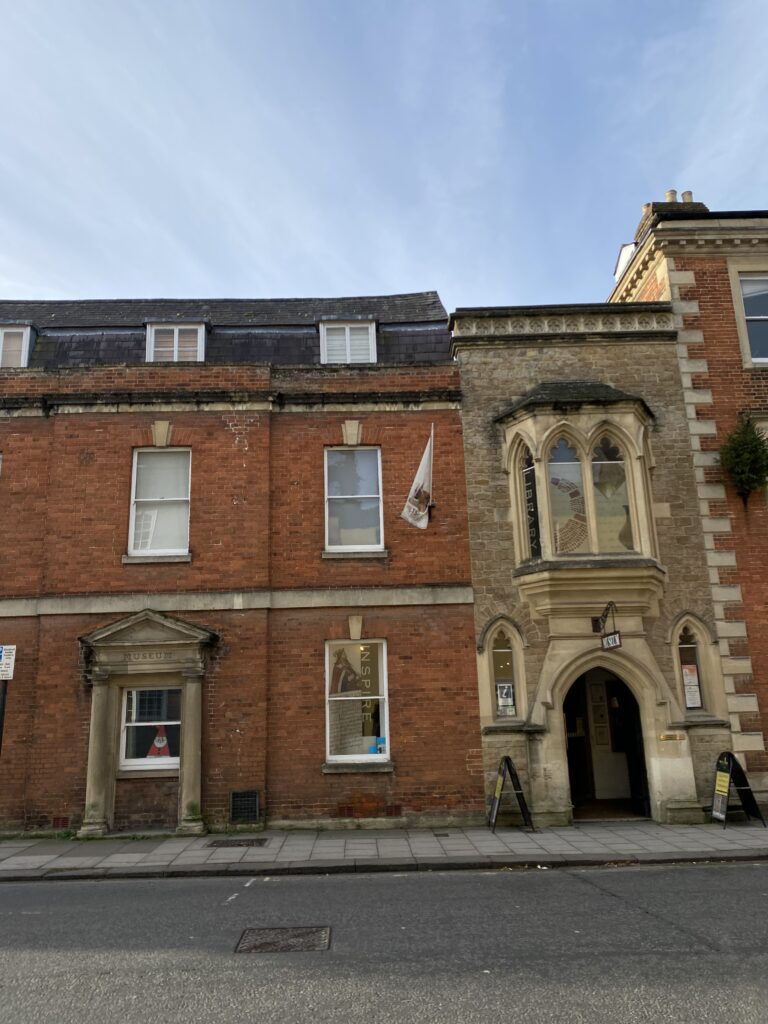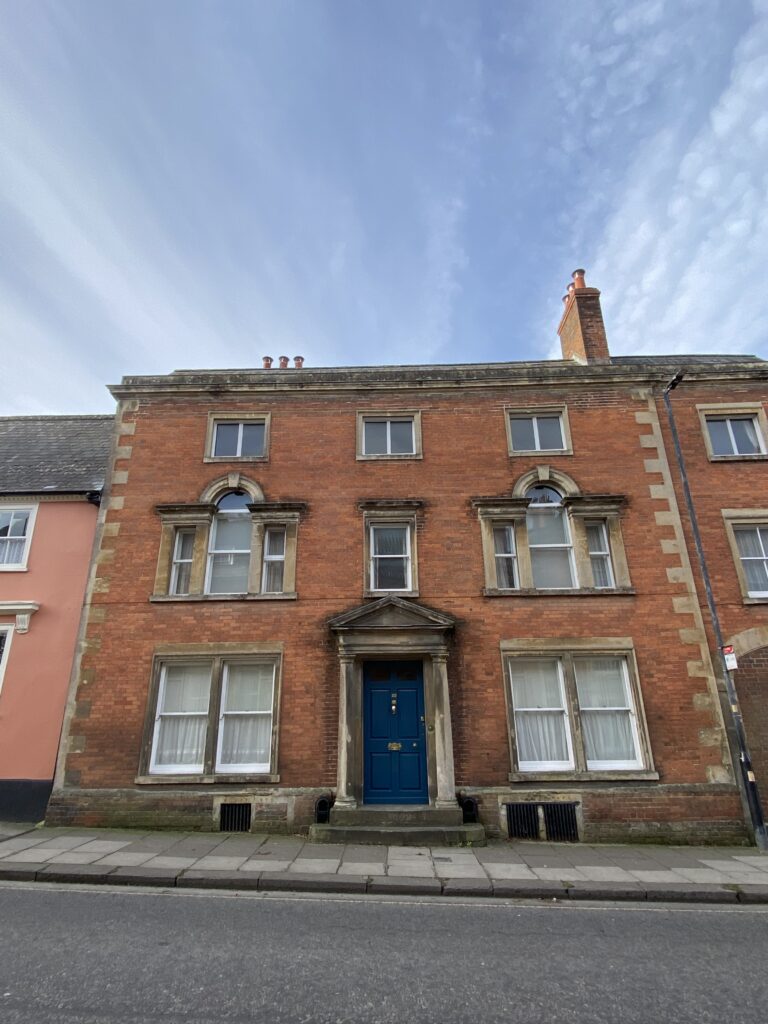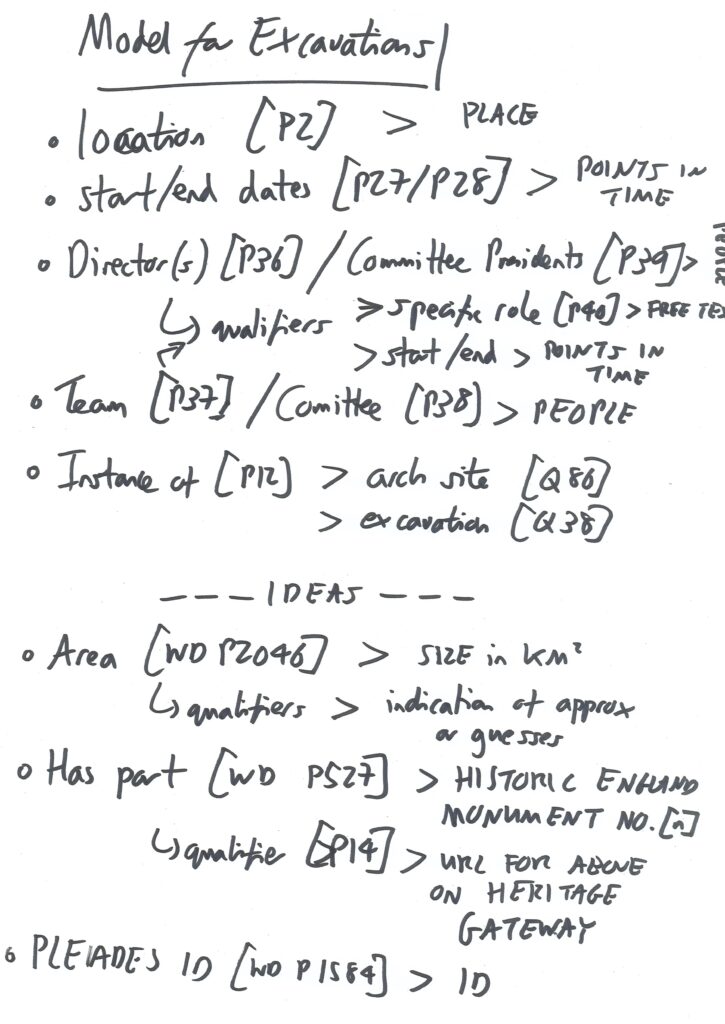In this blog post, Maddie Watson, a finalist Modern History and Politics student at the University of Southampton, introduces their work on Maud Cunnington as part of their Beyond Notability Internship, run by Southampton Digital Humanities. In this part, Maddie follows the traces of Maud into the Wiltshire countryside.
The first part of their blog can be read here.
Oliver’s Camp, 1907
I visited the Iron Age hill fort of Oliver’s Camp (Roundway Hill) with my mum on a cold, blustery day in December. The recent rain had transformed the usually reliable tracks into a sea of mud, challenging our every step as we ascended to the summit. In grappling with the slippery terrain (lacking sensible footwear), I couldn’t help but imagine the struggles faced by the Cunningtons without access to modern roads and vehicles. Panoramic views of Wiltshire spanned for miles from the top, and the hill’s lonely trees swayed in the wind. Looking around, memories of my bygone years played out before me: the joy of family walks, shared picnics, and convivial drinks with friends; the exhilaration of sledging down the hill’s steep banks in the winter, and the poignant recollection of dates and arguments. The hill, once a backdrop for my childhood escapades, revealed a hidden secret – two Bronze Age Barrows nestled in its soft curvatures. The same land that bore witness to ancient burials generously accommodated the playful exploration of my childhood self, providing a nurturing foundation for my future understanding of archaeology and history. No doubt, the landscape witnessed generations of children like me growing up, creating an unspoken bond between past and present.
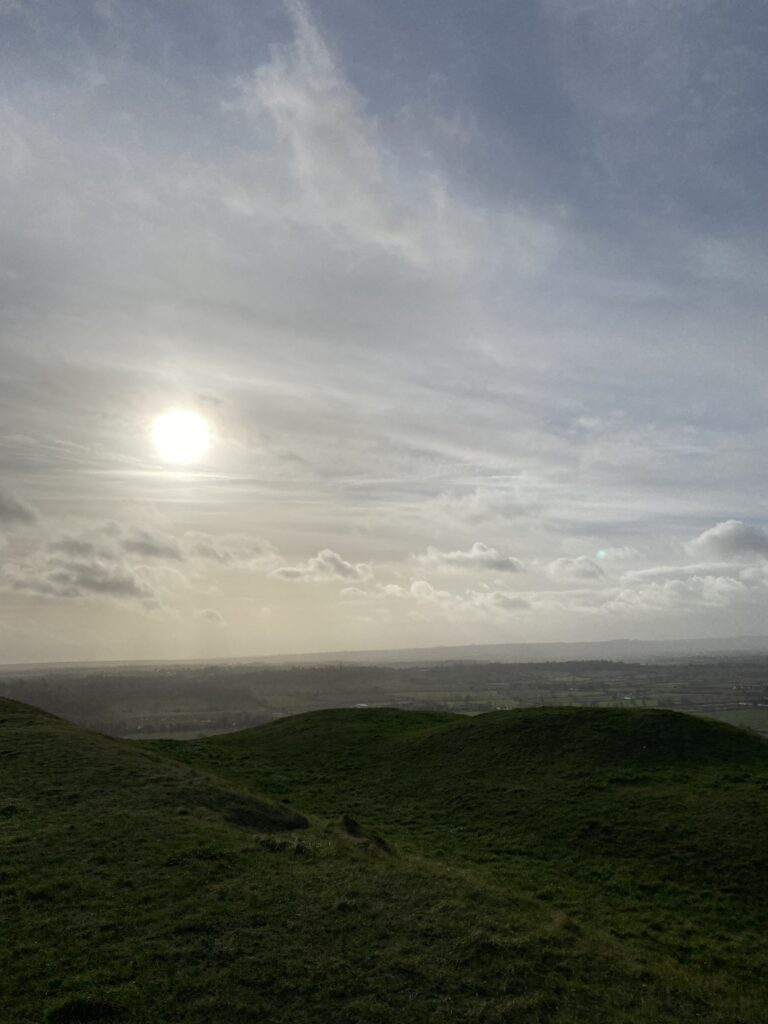
The landscape also witnessed Maud Cunnington’s archaeological endeavours and the significance of this site to the development of her report writing. Maud worked closely with her husband, Ben Cunnington. As described by R.H. Cunnington,
‘[he] would usually act as a pioneer, with one of the men opening up the ground for subsequent excavation… …Maud’s part was to decide what should be dug, and in what order, and to exercise general supervision’ (Roberts, 2002, 49).
Following the fieldwork, Maud was once again in charge and studied the finds, drew up the records, and wrote the excavation reports. Interestingly, despite Ben’s background in journalism and historical writing, Maud assumed the primary role in report creation. Ben would only ‘correct the style, not the matter: his admiration for her and her work was too deep to ever call that in question’ (Roberts, 2002, 50). Maud ‘realised that her own style was too romantic and insufficiently scientific’ and moved towards a factual presentation, supported with diagrams, detailed contextual information, and the inclusion of an explicit research strategy (Roberts, 2002, 50-1). She attempted to emulate that of her peers, using the work of Pitt-Rivers as guidance, whom she met during his excavations in Wansdyke a few years earlier. R.H. Cunnington praised the holistic nature of Maud’s reports, however, he claimed that she ‘had no gift for writing’ (Roberts, 2002, 50). This criticism seems severe when considering the rapid development of her writing style and growth in archaeological knowledge. Maud’s newfound expertise and insights from this excavation allowed her to identify a lack of earthwork exploration that surpassed the superficial examinations typically conducted by relic hunters.
Beyond academic circles, Maud’s long-term focus was to make historical and archaeological knowledge accessible to the public. The substantial body of her work included public lectures, published books, and articles contributed to the Wiltshire Archaeological and Natural History Magazine (WANHM), The Archaeological Journal, and Antiquity. This commitment led to her being recognised as one of the foremost archaeologists of her day, receiving a CBE in 1948 for her contributions to British archaeology.
However, Maud was heavily criticised by archaeologists such as Keiller for her rapid publication of excavation reports, branding them as amateur and insubstantial. Roberts (2002) noted that Michael Pitts (2000) echoed similar sentiments to Keiller and his contemporaries, claiming that Maud excavated too quickly and did not keep proper records. Such opinions highlight the difference in methods between an older and a younger generation, as well as the evolution of the aims of archaeological publications. Maud wrote primarily from a visibility-raising perspective, at a time when archaeological journals and magazines were considered to be public-facing publications for education and finance raising. In the 1920s, when Keiller came onto the scene, archaeological reporting began to change to a more scientific nature, explaining their apparent disdain for the older techniques used by Maud. Personal animosity from Keiller’s time undoubtedly influenced the next generation of archaeologists to be critical of her work and to deplore her methods. It is important to acknowledge that the methods used by Maud and her contemporaries of her time laid the foundations for the approaches later adopted by Keiller.
All Canning’s Cross, 1911
The discovery of an Iron Age village at All Canning’s Cross was pivotal in making ‘Maud Cunnington’s name as an archaeologist outside the confines of Wiltshire’ (Roberts, 2002, 52). All Canning’s Cross is unparalleled in significance as the first site in which the emergence of Iron Age technology was identified in Britain. Ironically, the Cunningtons began their self-funded excavations unaware of the site’s importance. The revelation of substantial amounts of pottery, bone tools, as well as bronze and iron tools, added an unexpected, but exciting layer to their archaeological journey. Though I did not personally explore this site, I was aware of its historical significance, having seen artefacts from the site in the Devizes Museum. The excavations at All Canning’s Cross were interrupted by World War One, as well as by the loss of the Cunningtons’ son Edward in 1917.
Kendrick and Hawkes (1932, 160) lauded Maud’s excavation report as ‘one of the finest publications in recent years.’ This accolade highlights the excellence of her work, as well as signifying Muad’s burgeoning confidence in her archaeological abilities and the development of original ideas on prehistory. This newfound assurance would eventually influence her interpretations of future excavations, such as her work on Woodhenge in 1926. The lessons learned and confidence gained at the excavation of All Canning’s Cross contributed to her perspectives on unravelling the mysteries of prehistoric sites.
Woodhenge (Durrington), 1926-7
On the same day that I explored Oliver’s Camp, my journey through ancient landscapes led me to the site of Woodhenge, a Neolithic wonder near Stonehenge. Enclosed by multiple timber concentric ovals, marked by unassuming concrete posts, Woodhenge unfolded before me. The site was discovered by aerial photography in 1925 and was excavated shortly after by the Cunningtons.
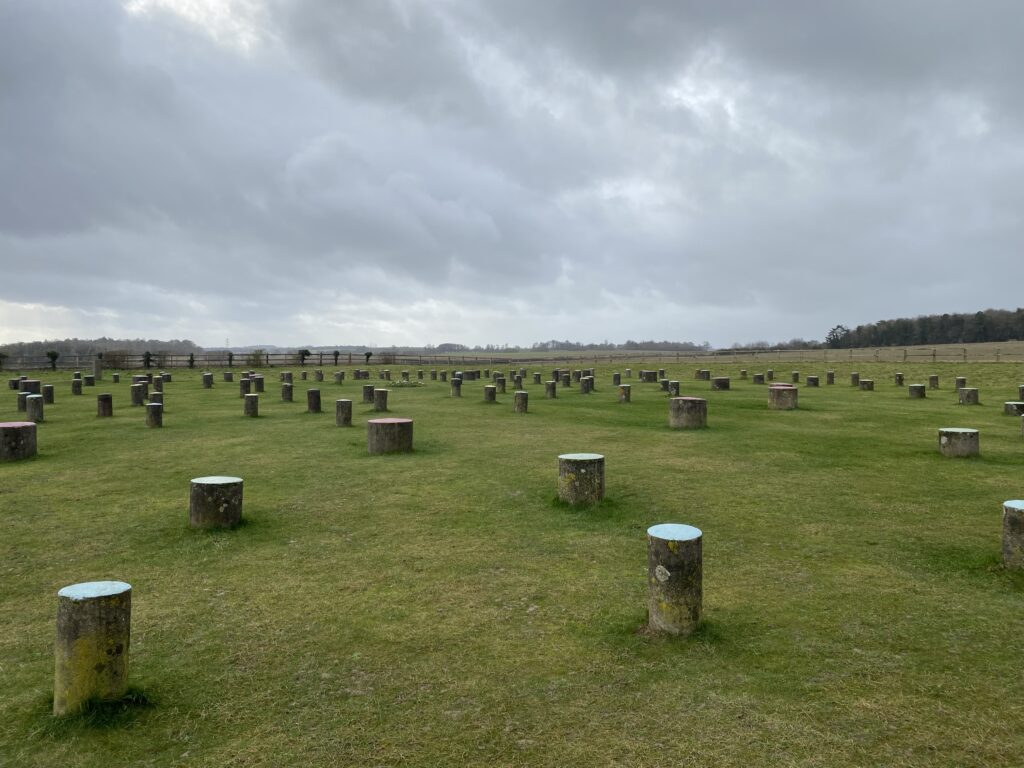
As I stood among the colour-coded posts, I remembered my initial underwhelmed reaction to the site as a child, assuming its insignificance in comparison to Stonehenge’s impressive structure. Now, the ambiguity of the site intrigues me. It is hard to imagine Woodhenge in its original form, with wooden pillars standing as high as 9 metres tall. The accompanying drawing by Peter Lorimer assisted with visualising the site’s previous atmospheric nature.
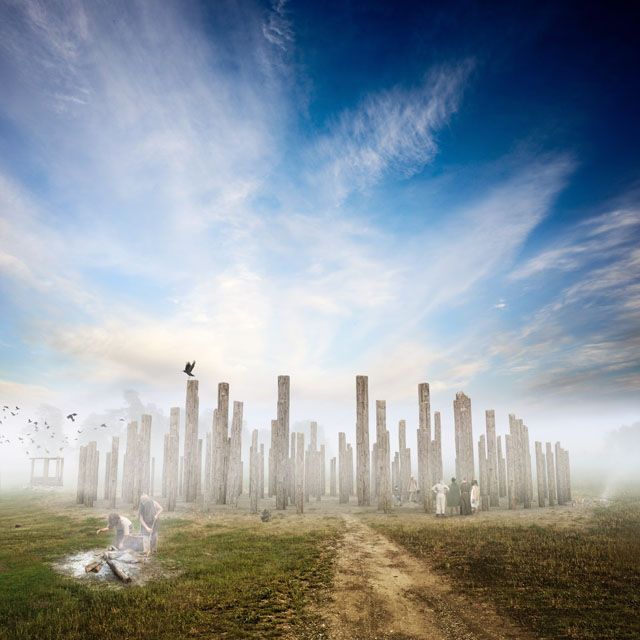
In the centre of Woodhenge, there was a grave marked by a flint cairn, from which the crouched inhumation of a young child had been excavated. Upon the cairn rested small offerings of pennies, hair bands, and small pebbles, a modern votive tribute to an ancestor created by archaeology (Williams, 2016). In the summer, it is common to see floral offerings here as well. The centrality of the grave to the monument forces visitors, both adults and children, to consider infant death and mortality and the fragility of life. The temporal distance between the burial and the present intensifies the enduring nature of human sympathy and the universal experience of grief.

Woodhenge’s profound layers became apparent through the captivating dance between the Neolithic past and the present manifested through these offerings. However, Woodhenge’s narrative extends beyond its physical remnants and intertwines with Maud Cunnington’s controversial interpretations. In 1929, Maud wrote detailed excavation reports, but her interpretation of the monument as a prototype for Stonehenge stirred heated debates within archaeological circles. She drew similarities between the monuments due to the northeast-to-southwest alignment of the oval post rings at Woodhenge that was the same as Stonehenge. Both monument’s entrances were built to align with the midsummer sunrise.
Maud asserted that based on misdated pottery at Woodhenge, Stonehenge was a single-phase monument of Iron Age date. This claim was greatly ridiculed and is partly responsible for her diminished reputation. Roberts asserts that Maud’s argument was continually flawed despite the demonstration of logic in turning to Stonehenge for comparisons:
‘Because she wanted Woodhenge to be a model for Stonehenge every possible shred of evidence was used to prove this and anything which contradicted her argument was ignored or distorted’ (Roberts, 2002, 53).
However, only hindsight disproved Maud’s interpretation of Woodhenge. Maud’s commitment to public awareness led to the fundraising of money to purchase the sites of Woodhenge and Stonehenge to place them into public ownership. This ensured that the sites would stand as educational and inspirational resources for generations to come. By doing so, Maud Cunnington contributed significantly to the democratisation of archaeological knowledge, allowing everyone to engage with and be inspired by the rich tapestry of prehistory. Her legacy serves as a reminder of the importance of preserving our collective history for generations to come.
List of works consulted:
Cunnington, M. (1930) ‘Stonehenge and the two-date theory’, The Antiquaries Journal, 10(2), pp. 103-113.
English Heritage (n.d.) History of Woodhenge. Available at: https://www.english-heritage.org.uk/visit/places/woodhenge/history/ (Accessed: 22 January 2024).
Historic England (1972) 33 and 33A, Long Street. Available at: https://historicengland.org.uk/listing/the-list/list-entry/1263549?section=official-list-entry (Accessed: 6 February 2024).
Kendrick, T.D. and Hawkes, C.F.C. (1932) Archaeology in England and Wales, 1914-1931. London: Methuen.
Moshenska, G. (2016) ‘Maud Cunnington’, Trowelblazers, 16 April. Available at: https://trowelblazers.com/2016/04/14/maud-cunnington/ (Accessed: 16 January 2024).
Pitts, M. (2000) Hengeworld. London: Century.
Roberts, J. (2002) ‘That terrible woman’: the life, work and legacy of Maud Cunnington’, The Wiltshire Archaeological and Natural History Magazine, 95, pp. 46-62.
Smith, B. (2000) The Gender of History: Men, Women, and Historical Practice. Harvard: Harvard University Press.
Taylor, H. (n.d.) Six Groundbreaking Female Archaeologists. Available at: https://www.english-heritage.org.uk/learn/histories/women-in-history/six-groundbreaking-female-archaeologists/ (Accessed: 16 January 2024).
Williams, H. (2016) ‘A Tomb of the Unknown Child: The Ancestor of Woodhenge’, Archaeodeath, 8 April. Available at: https://howardwilliamsblog.wordpress.com/2016/04/08/a-tomb-of-the-unknown-child-the-ancestor-of-woodhenge/ (Accessed: 23 January 2024).
Wiltshire Museum (n.d.) Pots excavated by Maud Cunnington. Available at: https://www.wiltshiremuseum.org.uk/?artwork=pots-excavated-by-maud-cunnington (Accessed: 22 December 2023)
